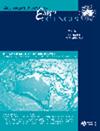Petrogenesis of the Hoy lava field, a long-lived continental mafic volcanic province in eastern Australia
IF 0.9
4区 地球科学
Q3 GEOSCIENCES, MULTIDISCIPLINARY
引用次数: 0
Abstract
Abstract Small-scale continental basaltic fields can erupt with little warning and bring deep undegassed magmas to the surface rapidly. To explore the lifetime, petrogenesis and plumbing system architecture feeding such basaltic lava fields and compare them with large-scale shield volcanoes, we have focused on the Hoy lava field, central Queensland, Australia. 40Ar/39Ar geochronology, elemental and isotopic whole-rock geochemistry and mineral chemistry on selected Hoy samples reveal long-lived volcanism of ca 50 Ma and magma storage at mantle depths, notably different from the comparatively short duration (3–5 Myr) and crustal magma storage depths of shield volcanoes. In this study, four Hoy lava-field eruptive intervals spanning ca 50 Ma were investigated: 67.5 ± 0.3 Ma, 32.3 ± 0.6–31.6 ± 0.7 Ma, 21.9 ± 0.5 Ma and 18.1 ± 0.3 Ma. In all four eruptive events, samples are porphyritic alkali basalts and trachybasalts (11.41–6.45 wt% MgO) with incompatible element concentrations and Sr–Nd–Pb isotope ratios dominantly derived from a metasomatised sub-continental lithospheric mantle (SCLM) source with an enriched mantle I (EMI) signature. Complex crystal populations show major- and trace-element variations reflecting fractional crystallisation, magma recharge, magma mixing and mantle xenocryst entrainment. Clinopyroxene–melt thermobarometry indicates magma storage in SCLM reservoirs at ∼30–47 km depths. The nearby larger but shorter-lived (3–5 Myr) Buckland central volcano has similar source compositions; however, magma storage is limited and concentrated in the crust, resulting in increased crustal contamination. The results suggest that basaltic centres of contrasting scale and longevity are linked to distinct magma production mechanisms, fluxes, ascent and differentiation. KEY POINTS The Hoy lava field erupted for over 50 Ma, with at least four eruptive periods. The Hoy magmas are all derived from the same source: SCLM with an EMI signature. Hoy lavas have a complex history of magma recharge, magma mixing, fractionation and xenocryst entrainment at mantle depths (30–47 km). Hoy lavas experienced deeper storage, limited contamination and faster ascent than the nearby Buckland central volcano.霍伊熔岩田的岩石成因,这是澳大利亚东部一个长期存在的大陆基性火山省
本文章由计算机程序翻译,如有差异,请以英文原文为准。
求助全文
约1分钟内获得全文
求助全文
来源期刊

Australian Journal of Earth Sciences
地学-地球科学综合
CiteScore
2.80
自引率
8.30%
发文量
45
审稿时长
6-12 weeks
期刊介绍:
Australian Journal of Earth Sciences publishes peer-reviewed research papers as well as significant review articles of general interest to geoscientists. The Journal covers the whole field of earth science including basin studies, regional geophysical studies and metallogeny. There is usually a thematic issue each year featuring a selection of papers on a particular area of earth science. Shorter papers are encouraged and are given priority in publication. Critical discussion of recently published papers is also encouraged.
 求助内容:
求助内容: 应助结果提醒方式:
应助结果提醒方式:


